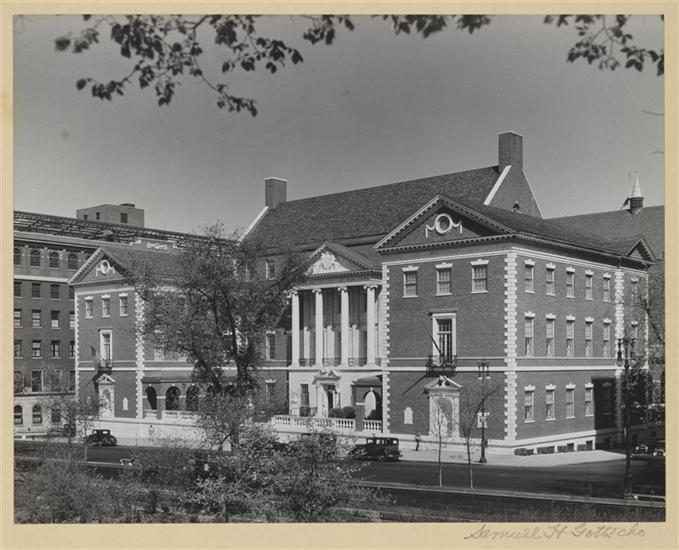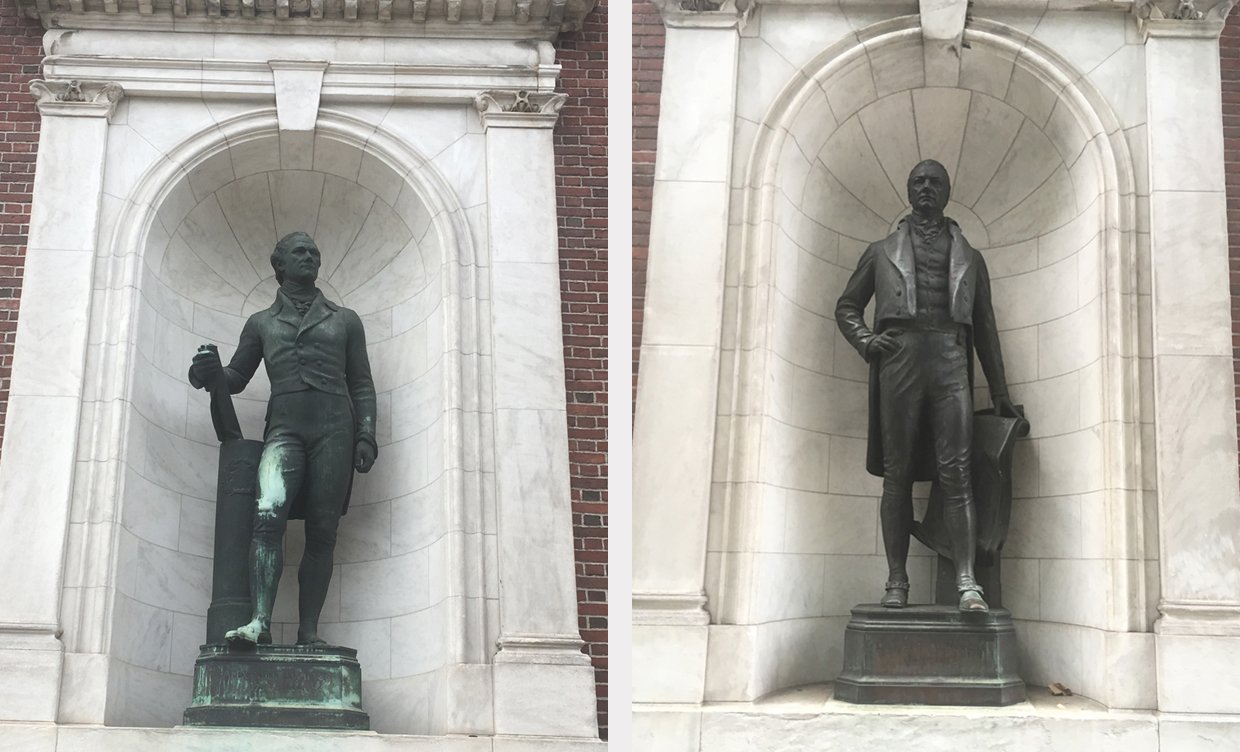Conserving the Adolph Alexander Weinman Sculptures on the Museum’s Façade
Initial Steps, Research, and Testing
Thursday, August 10, 2017 by
It’s not every day that collections care at the Museum of the City of New York involves a giant boom crane and a forklift. However, just recently, the Museum removed two 1,100 pound statues – likenesses of statesman Alexander Hamilton (1757-1804) and senator, former New York City Mayor, and New York State Governor DeWitt Clinton (1769-1828) – from the façade of the building in order to send them for cleaning and conservation. These two statues were designed and executed by noted sculptor Adolph Alexander Weinman (1870-1952), specifically for installation in the marble niches on either side of the main entrance to the Museum on Fifth Avenue. You’ll see in the image below, taken shortly after the completion of the Museum’s building in 1932, the niches are empty as the sculptures weren’t installed until 1941.
Adolph Weinman was born in Germany, immigrated to New York’s Lower East Side, and attended Cooper Union. He began his career apprenticing at a wood and ivory carving firm, and later assisted many well-known sculptors, including Olin Levi Warner, Auguste St. Gaudens, Charles Niehaus, and Daniel Chester French, and went on to accept commissions from the architecture firm of McKim, Mead, and White. His work appears in New York on the façade of the Morgan Library (originally J. Pierpont Morgan’s home), the Municipal Building in downtown Manhattan, the U.S. Customs House at Bowling Green, and the Bronx County Court building, and was found in the interior of the now demolished Penn Station.
As outdoor sculptures, these works have been subject to the effects of the environment for over seventy-five years, and the Museum has long been looking for a way to address their condition. At long last, this conservation project, which was sponsored by American Express, was finally able to begin late 2016 with initial testing and research. The images below show the statues just prior to their removal July 27. Both are showing the effects of their exposure to the elements, such as the discoloration along Hamilton’s left knee, and both sculptures are quite dark in tone.
It may not seem that strange for an outdoor sculpture to be dark in color, especially if you are used to looking at bronze sculptures, but these two works are cast from a nickel/ copper/ zinc alloy, that was originally quite a silvery tone. This picture from the collection shows Alexander Hamilton around the time it was originally installed. Any conservation approach is multi-faceted; we want to both clean and to stabilize the object, while still accurately represent the sculptor’s original intentions.
Not only did the Museum turn to our own records to learn more about these sculptures, but also Adolph Weinman’s papers at the Archives of American Art, and the Roman Bronze Foundry records at the Amon Carter Museum of Art. The sculptor’s papers included correspondence with Joseph H. Freedlander, the architect of the Museum’s building, which states that the original intention was for marble statues in the niches. In response, the sculptor proposed casting the works in a nickel/ copper/ zinc alloy (also referred to as nickel bronze) that would appear light and consistent with the marble. In a letter from October 31, 1940, the sculptor states, “If the niches were any color than white marble, I would not have suggested nickel bronze, but it is so evident to me that a dark color bronze would produce too glaring a contrast.” The same letter goes on to state that gold statues were initially proposed as an alternative, as well!
The records from the Roman Bronze Foundry confirmed a 16% nickel bronze alloy, but modern technology allows us to verify this even further. The Museum has contracted with Conservation Solutions, Inc. to carry out this work, and the project is led by Co-owner and Senior Conservator Mark Rabinowitz. Mark visited the Museum with the goals of verifying both the components of the metal alloy, and the means by which the statues were affixed within the niches (more on that in our next post on this topic!). During the cleaning tests, Mark cleaned the surface of the side of the base of the DeWitt Clinton sculpture, and using Portable X-ray Flourescence Spectrocopy as different layers were exposed. This method provides for a non-destructive means of assaying the metal composition. Eventually, an even, silvery-grey base metal surface was exposed, and testing revealed it to closely match the documented formula of the casting alloy: 16.62% nickel, 64.61% copper, 13.24% zinc, 4.70% silicon, and trace amounts of other metals.
As mentioned, this initial work was just part of the investigative research necessary to develop a treatment plan, and eventually remove the sculptures. Stay tuned to learn more about how Mark was able to determine the means by which the sculptures were secured to the building, and how that helped us plan for their removal!
The Museum is grateful to American Express for their support of this project.
Additional support provided by The Barker Welfare Foundation.


![United States Work Projects Administration. [Statue of Alexander Hamilton outside the Museum of the City of New York], ca. 1945. MCNY X2010.11.10382. United States Work Projects Administration. [Statue of Alexander Hamilton outside the Museum of the City of New York], ca. 1945. MCNY X2010.11.10382.](/sites/default/files/X2010_11_10382.jpg)


